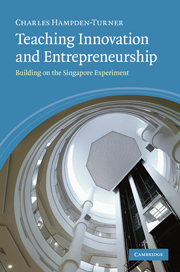Book contents
- Frontmatter
- Contents
- List of grids
- List of dilemmas
- Acknowledgements
- Introduction
- 1 Singapore’s challenge
- 2 The entrepreneurial ecosystem
- 3 How can innovative pedagogies be measured?
- 4 Co-defining innovative education
- 5 The Singapore results
- 6 Results of the Mandarin-speaking programme
- 7 Reconciling values
- 8 ‘It is only the Hawthorne Effect’
- 9 The programme that cannot stand still
- 10 Innovation and the future of the university
- 11 What are the implications of being able to teach innovation?
- 12 Is a new creative class arising?
- Notes
- Bibliography
- Appendices
- General index
- Index of dilemmas and reconciliations
4 - Co-defining innovative education
how the instrument was created
Published online by Cambridge University Press: 05 July 2014
- Frontmatter
- Contents
- List of grids
- List of dilemmas
- Acknowledgements
- Introduction
- 1 Singapore’s challenge
- 2 The entrepreneurial ecosystem
- 3 How can innovative pedagogies be measured?
- 4 Co-defining innovative education
- 5 The Singapore results
- 6 Results of the Mandarin-speaking programme
- 7 Reconciling values
- 8 ‘It is only the Hawthorne Effect’
- 9 The programme that cannot stand still
- 10 Innovation and the future of the university
- 11 What are the implications of being able to teach innovation?
- 12 Is a new creative class arising?
- Notes
- Bibliography
- Appendices
- General index
- Index of dilemmas and reconciliations
Summary
I have explained that for us the choice of ideals and their later combined realization defines entrepreneurship and innovation, but there are numerous variations upon this underlying theme. We chose eleven highly contrasting aims of education. Each of these included a traditional, realistic aim contrasted with a novel, idealistic aim, embodied within TIP itself. The traditional aims were important to Singapore’s quest for a just meritocracy and the channelling of educational resources to the most able and studious. The entrepreneurial aims were essential to Singapore moving from followership to leadership, defining excellence for itself and then realizing this.
We were particularly concerned to discover whether encouraging students to be innovative might detract from or subvert the traditional canons of education. Entrepreneurs have not always been respectful of education. Henry Ford notoriously said that history is bunk. In the sixties and seventies extreme right-wing membership in the USA was found to correlate with ‘status incongruence’, that is high levels of commercial success but low educational levels. Senator Barry Goldwater, the American candidate for President, wanted to ‘saw off the Eastern seaboard and have it float out to sea’ with Harvard, Yale, Princeton and MIT graduates. Many supporters of entrepreneurs have been rabidly anti-intellectual. It has been said of those boasting that they are ‘self-made men’ that ‘they relieve the Almighty of a heavy responsibility’. Was there a danger of TIP producing such characters?
- Type
- Chapter
- Information
- Teaching Innovation and EntrepreneurshipBuilding on the Singapore Experiment, pp. 58 - 70Publisher: Cambridge University PressPrint publication year: 2009



